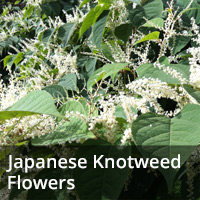
 The broad, heart/shield shaped leaves emerge in a zig-zag formation along the branches. The off-white flowers bloom during the summer months and grow in clusters of small spiky stems covered with tiny flowers. As knotweed reaches the end of its yearly lifecycle, the flowers and leaves drop and the stem dies turning to a dry brown cane.
The broad, heart/shield shaped leaves emerge in a zig-zag formation along the branches. The off-white flowers bloom during the summer months and grow in clusters of small spiky stems covered with tiny flowers. As knotweed reaches the end of its yearly lifecycle, the flowers and leaves drop and the stem dies turning to a dry brown cane.
At the base of the stems is a knotty lumpy section called the crown, this is commonly covered with fine brown tendrils giving the crown material a hairy appearance. Close inspection will reveal many small purple shoots on the crown.
 The rhizome, buried underground has a woody, knotty appearance and is brown in colour. Scraping back the relatively thin brown outer layers or snapping the rhizome reveals a yellow/orange inner core. Rhizome has a carrot like texture and will tend to break cleanly and requires only a moderate amount of force to snap with your hands. The orange interior is less obvious in fine tendrils at the ends of sections of rhizome making them difficult to identify without larger sections of root nearby. This is problematic during excavations as these sections of rhizome are the most effective at regenerating if left in the ground.
The rhizome, buried underground has a woody, knotty appearance and is brown in colour. Scraping back the relatively thin brown outer layers or snapping the rhizome reveals a yellow/orange inner core. Rhizome has a carrot like texture and will tend to break cleanly and requires only a moderate amount of force to snap with your hands. The orange interior is less obvious in fine tendrils at the ends of sections of rhizome making them difficult to identify without larger sections of root nearby. This is problematic during excavations as these sections of rhizome are the most effective at regenerating if left in the ground.
 In the UK there are also Giant and Compact Knotweed varieties and a hybrid variety of giant and Japanese knotweed. Giant Knotweed can grow to a height of 5m and has larger leaves, the hybrid will share some of the characteristics of Giant Knotweed and some of Japanese Knotweed although this can vary a bit from plant to plant. The compact knotweed variety grows to only around 1m. In other characteristics such as leaf shape and colour and the appearance of stems these varieties very closely resemble Japanese Knotweed.
In the UK there are also Giant and Compact Knotweed varieties and a hybrid variety of giant and Japanese knotweed. Giant Knotweed can grow to a height of 5m and has larger leaves, the hybrid will share some of the characteristics of Giant Knotweed and some of Japanese Knotweed although this can vary a bit from plant to plant. The compact knotweed variety grows to only around 1m. In other characteristics such as leaf shape and colour and the appearance of stems these varieties very closely resemble Japanese Knotweed.
A special mention should be made with regards to knotweed which has been treated with herbicide either the following growing season or in the event of a sub-lethal dose in early season treatment. These plants will likely be shrunken and malformed and may appear to be radically different to the normal growth of Japanese Knotweed. In this instance an experienced professional may be required to identify the plants.
2021
Everything you wanted to know about Japanese Knotweed but were afraid to ask
Japanese Knotweed can be the stuff of nightmares for developers and homeowners alike. Not sure if you have a Knotweed problem? Looking for the answers? This free eBook will help educate, identify, treat and address the importance of eradicating Japanese Knotweed.


